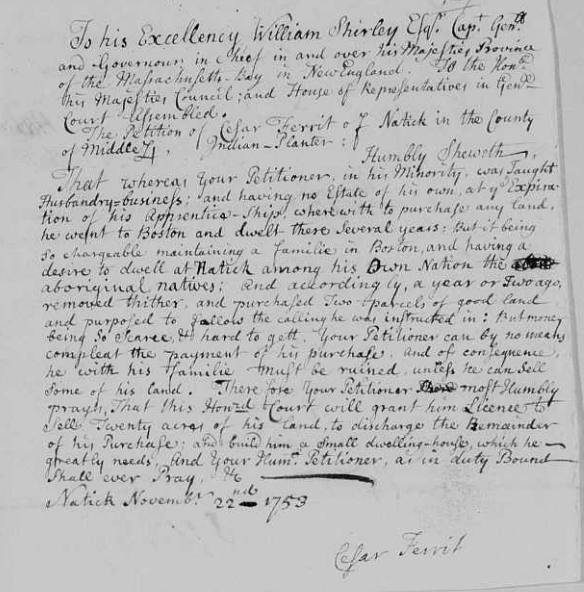
Caesar Ferrit was an eighteenth-century Afro-Indigenous resident of Natick. He and two of his sons served during the American Revolutionary War.
The Ferrit Family: Loyalty to their Nation
If we know one thing about Caesar Ferrit (Indigenous/Black) and his sons, Thomas and John, it is that they served their nation. The three men spent significant portions of their lives in Natick and fought bravely throughout the American Revolution. Caesar Ferrit and his family members' actions, both in wartime and peacetime, demonstrate their drive to remain in their community of Natick.
Caesar Ferrit’s 1753 petition to the Massachusetts General Court. The petition explains that he had “a desire to dwell at Natick among his Own Nation, the aboriginal natives.” Source: Massachusetts State Archives and familysearch.org
Caesar moved to Natick through Milton and Boston, possibly originally from the West Indies. He learned farming in Milton. He later moved to Boston and worked as a coachman for a wealthy family. Legend states he and his boss’s ward, a white woman named Naomi, had a dramatic romance. Naomi was already engaged to a wealthy man when she and Caesar fell in love. She had to choose between marrying the rich man or marrying Caesar. She chose Caesar. They moved to Natick to find work and to raise their seven children. According to a 1753-century petition to the Massachusetts General Court, Caesar specifically moved to Natick to be with other Indigenous people.
Caesar was legally seen as a “Natick Indian” and petitioned the General Court multiple times during the 1750s to sell parcels of Natick land. Caesar sold land to pay debts that resulted from family illnesses and other difficulties. He also needed money to build a house. His petitions demonstrate that he had many shared lived experiences with other residents of Natick after King Philip’s War into the eighteenth century. They also showcase one of the ways he fought to remain in a community where he felt accepted.
Caesar and his son, John, answered the call to action immediately during the battles of Lexington and Concord. They famously stationed themselves in a house in Lexington and shot at British troops as they retreated from Concord. They hid in the house's basement as British troops searched for them. They were never found.
Father and son re-enlisted in the army together in 1775 and 1776. In March 1781, they enlisted in Captain Samuel Chamberlain's company and marched to Rhode Island under an order of John Hancock. John Ferrit additionally served in a “secret expedition” that brought him to Rhode Island in 1777.
Thomas Ferrit fought at Lexington and Concord rather than alongside his father and brother. Thomas lived in Dedham and enlisted with Dedham’s Fourth Parish Regiment. Thomas’s military service lasted two days at the beginning of the war. In 1777, he married Lydia Fagins in Natick.
Soldiers fought in the American Revolution for a wide variety of reasons. The motivations of the Ferrit men need to be clarified. As Caesar and John risked their lives as soldiers multiple times, there is some probability that they felt some loyalty to the “Patriot cause.” Like many eighteenth-century Indigenous men, they likely used the military as a stable financial opportunity. Caesar was paid for his service and likely used the money to ensure his family could live comfortably in Natick without selling more of his land.
by Gail Coughlin
Selected sources and additional reading:
Natick Historical Society Collections.
Quintal Jr., George. Patriots of Color: A “Peculiar Merit” African Americans and Native Americans at Battle Road & Bunker Hill. Boston: Division of Cultural Resources, Boston National Historic Park, 2004.


